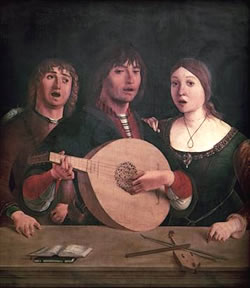The Parthenopean plectra instruments
Introduction
by Vincenzo Schisano
(Translated by Marianna Mastro)
The origin of the plectra instruments are uncertain, obscure and lost in the mists of time. The first models historically documented arrive from Far East: Tambourà, Tammourah, Gut-Komm and Poun goum.
 From
the instruments will then be made the lute or “liuto” (from
the Arabic “al ud” “laud”, “leus” “luc” and “eoud”),
arrived in Spain from Africa during the second half of the 10th century
and then arrived in France and Italy, from which derived a series of instruments:
the “chitarrone”, the “tiorba”, the “liuto
attiorbato” (all called vaguely “arciliuti”), the “mandolino” -
mandolin (also called the mandorlino”), the “mandola” – tenor
mandolin ( also called “mandora”, pandola”, and “quinterna”)
the “mandolone” - bass mandolin (or “arcimandola”)
and the “mandoloncello”.
From
the instruments will then be made the lute or “liuto” (from
the Arabic “al ud” “laud”, “leus” “luc” and “eoud”),
arrived in Spain from Africa during the second half of the 10th century
and then arrived in France and Italy, from which derived a series of instruments:
the “chitarrone”, the “tiorba”, the “liuto
attiorbato” (all called vaguely “arciliuti”), the “mandolino” -
mandolin (also called the mandorlino”), the “mandola” – tenor
mandolin ( also called “mandora”, pandola”, and “quinterna”)
the “mandolone” - bass mandolin (or “arcimandola”)
and the “mandoloncello”.
In this section will be described only the “pletra” and “pinch” instruments which have been and are still part of the popular traditions and Parthenopean folklore and which represent the principal elements for the formation of any “Plectra Orchestra”.
A representative image to which Naples is associated to all over the world is the mandolin and for this reason this instrument will have the privilege of being treated more widely compared to the other instruments (which are certainly of no minor importance).
This “special treatment” is due to the fact that the major mandolin manufacturers, of all times, have been and still are Neapolitan (it is also due to them, therefore, the diffusion all over the world of the Parthenopean folklore).
Following these preliminary remarks, please allow me to make a comment completely personal and widely debatable. Since the last ten years, it has become always more diffused the habit to prevalently execute in “staccato” the notes of the compositions dedicated to the plectra instruments.
Practically some very rare passages are left in “trillato”, where often there is the impression of a double mordent (or even simple) rather than a trill. This executive practice, maybe adopted because it is much easier or to give more liveliness to the executions, doesn’t raise any enthusiasm in the writer, essentially because of the constitution of these instruments, all with double chords tuned in unison.
The main reason for the adoption of this practice was, and is, that of helping the execution of the trill, very difficult to achieve with only one chord available; the “staccato” was reserved to the execution of rapid passages and/or bright.
Furthermore, the regulation on behalf of the performer of the velocity of the trill, together with the variation of the intensity, create the most various atmospheres , whose quantity and quality is subordinated only to the ability and the musicality of the performer.
To sustain all that has been mentioned above, and concluding my personal comment, here is an example: playing the notes staccato of the strophe “Torna a Surriento” equals to the cutting off of the diction of all the words of the verses corresponding, with an effect, for the listener, presumably tragicomic.
© Copyright 2003 Vincenzo Schisano. All rights reserved.
